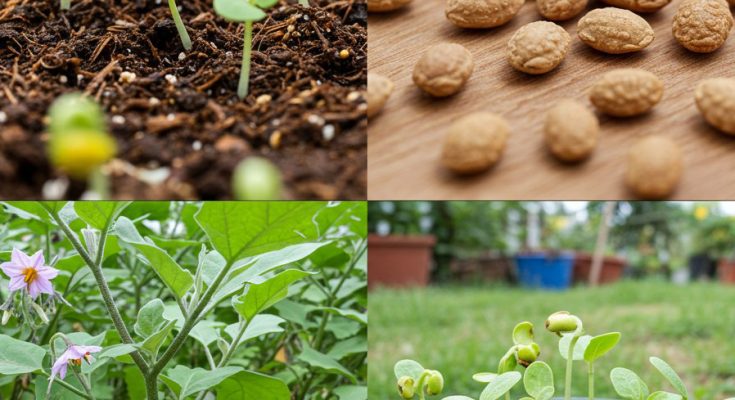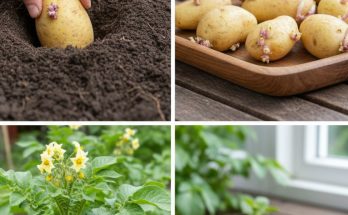Growing eggplants, particularly the popular Black Beauty variety, in containers is an excellent way to enjoy fresh, homegrown vegetables, even if you have limited space. Whether you’re growing them on a balcony, patio, or small garden, container gardening allows you to cultivate this delicious vegetable with ease. In this guide, we’ll walk you through the process of growing eggplants from seed in containers, providing tips for success.
Why Grow Eggplants in Containers?
Growing eggplants in containers offers several advantages, especially for gardeners with limited space:
-
-
Space-saving – Eggplants can be grown in smaller spaces like balconies, patios, or even windowsills.
-
Control – You can control the soil quality and move your container to optimize sunlight exposure.
-
-
Mobility – If temperatures become too cold or too hot, you can move your container to protect your plants.
-
Higher yields – When grown in optimal conditions, eggplants in containers can produce a bountiful harvest.
Container gardening is ideal for Black Beauty eggplants, as it allows you to give these heat-loving plants the care they need to thrive.
What You’ll Need
Before you begin, gather the following materials:
-
-
Black Beauty eggplant seeds (available at most garden centers or online)
-
Large containers (at least 5 gallons in size, with drainage holes)
-
High-quality potting mix (preferably one that is light and well-draining)
-
-
-
Compost or organic matter (optional for improved fertility)
-
Fertilizer (optional)
-
Watering can or hose
-
-
A sunny location that receives 6–8 hours of direct sunlight daily
Step-by-Step Guide to Growing Eggplants from Seed in Containers
1. Choose the Right Container
The container you choose for growing eggplants is crucial to their success. Eggplants need plenty of space for their roots to spread out, so select a container that is at least 5 gallons in size, although larger is better. The container should also have drainage holes at the bottom to ensure that excess water can escape.
-
Plastic, fabric, or ceramic pots are all great choices for container gardening.
-
Make sure the container has enough space for the plant to grow tall, as Black Beauty eggplants can reach up to 3 feet in height.
2. Prepare the Soil
Eggplants thrive in rich, well-draining soil. A high-quality potting mix will provide the necessary nutrients for strong growth, but you can improve it by adding some compost or organic matter. The soil should retain moisture but not become soggy, as this can cause root rot.
-
-
Fill the container with the potting mix, leaving about an inch of space at the top for watering.
-
If desired, mix in balanced fertilizer or compost to enhance soil fertility.
-
3. Plant the Seeds
To start growing Black Beauty eggplants from seed, follow these steps:
-
-
Start seeds indoors about 8–10 weeks before the last expected frost date. Eggplant seeds need warm soil to germinate, so it’s best to start them indoors early in the season.
-
-
-
Sow seeds about 1/4 inch deep into small containers or seed trays. Space the seeds 2 inches apart.
-
Keep the seeds in a warm area (about 70–80°F) and ensure they receive plenty of light. A seedling heat mat or grow lights can help speed up the germination process.
-
Keep the soil moist but not soggy during the germination period. The seeds should germinate in 7–14 days.
-
Once the seedlings have grown large enough to handle, and after all danger of frost has passed, you can transplant them into your larger containers.
4. Transplanting Seedlings into Containers
When your eggplant seedlings have at least 2–3 sets of leaves and are strong enough to handle, they are ready to be transplanted into their permanent container. Here’s how to transplant:
-
-
Carefully remove the seedlings from their seed trays, being careful not to disturb the roots too much.
-
Place one seedling per container, ensuring the roots are spread out comfortably and not cramped.
-
-
Fill the container with additional potting mix around the seedling to hold it in place, and gently water it in.
5. Sunlight and Temperature
Eggplants love full sun, so make sure your container is placed in a spot where it will receive 6–8 hours of direct sunlight daily. The more sunlight, the healthier the plant will be.
-
Ideal temperatures for eggplants are between 70–85°F. Eggplants are sensitive to cold, so make sure they’re kept warm. If you’re growing them indoors or in cooler climates, consider using a grow light to provide extra light and warmth.
-
If you live in a region with cooler temperatures, wait until all danger of frost has passed before moving your eggplants outside.
6. Watering and Fertilizing
Eggplants need consistent watering to grow well, but they don’t like to be waterlogged. Keep the soil moist, but ensure there is proper drainage in the container.
-
-
Water regularly, aiming to keep the soil consistently moist, but not soaking wet. Avoid letting the soil dry out completely.
-
Fertilize your eggplants every 2–4 weeks with a balanced, slow-release fertilizer or liquid fertilizer. Eggplants are heavy feeders and will benefit from the extra nutrients, especially during their growing and fruiting stages.
-
7. Pollination and Care
Eggplants are self-pollinating, meaning they do not require another plant to produce fruit. However, they still benefit from gentle air movement to help with pollination. If you’re growing eggplants indoors, you can help by gently shaking the plants or using a small paintbrush to transfer pollen between flowers.
-
-
Keep an eye out for pests like aphids, whiteflies, or spider mites. If you notice any pests, remove them by hand or use an organic insecticide.
-
-
Prune any dead or yellowing leaves to keep the plant healthy.
8. Harvesting the Eggplants
Black Beauty eggplants are ready to harvest when the fruit has reached full size (typically 6–8 inches long) and the skin is shiny and firm. To check if they’re ready, gently press the skin with your thumb—if it bounces back, the eggplant is ready to be picked.
-
Use sharp scissors or pruning shears to cut the eggplants from the plant, leaving about 1 inch of the stem attached.
-
Harvest regularly to encourage the plant to produce more fruit.
Conclusion
Growing Black Beauty eggplants in containers is a great way to enjoy this delicious vegetable without needing a large garden. With the right container, soil, and care, you can successfully grow healthy, vibrant eggplants from seed. Follow these simple steps—planting, watering, providing sunlight, and harvesting—and you’ll be able to enjoy fresh, homegrown eggplants right from your own patio or balcony.


